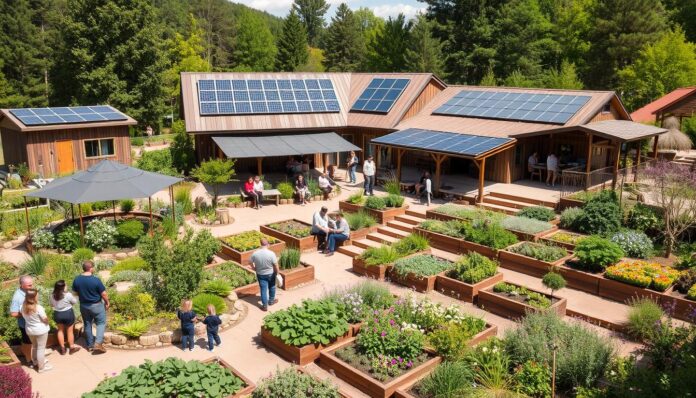Imagine if permaculture sites could make a lot of money while teaching us about green living. This idea is catching on, with places offering green amenities and special experiences. For example, permaculture spots can host educational programs, workshops, and hands-on activities. These show how to care for the land, drawing in many visitors and bringing in good money.
Permaculture tourism is a great deal for everyone. It helps local economies grow while teaching us to live sustainably. As more people want to travel green, permaculture sites can offer workshops, tours, and activities. This not only cuts down on harm to the environment but also helps the local community.
By using permaculture in tourism, local areas can grow stronger and greener. This way, they don’t rely so much on old ways of making money. It also helps keep nature safe, supports biodiversity, and boosts the local economy. This makes permaculture tourism a smart choice for a greener future.
Key Takeaways
- Permaculture visitor facilities can generate revenue while promoting sustainable tourism
- Eco-friendly amenities and unique experiences can attract a large number of visitors
- Permaculture tourism can create a win-win situation for local economies and the environment
- Sustainable tourism experiences can help reduce environmental footprint and support local communities
- Permaculture principles can be incorporated into tourism initiatives to promote biodiversity and conservation
- Local communities can benefit from permaculture tourism by fostering ownership and sustainable practices
Understanding Permaculture Tourism
Permaculture tourism focuses on sustainable travel. It’s about green lodging and places that care for the planet. It lets tourists help make travel better for the environment.
Permaculture tourism has many benefits. For example, it can boost insect numbers by 30% over regular farming. It also saves water by 30-50% with drip irrigation. These steps help make travel less harmful to the environment.
Key permaculture tourism ideas include caring for the earth and people, and sharing resources fairly. These ideas can shape travel choices, from staying in environmental accommodations to joining local tours. By following these ideas, travelers can help the planet and support local communities.
| Principle | Application in Tourism |
|---|---|
| Care for the earth | Choosing eco-friendly accommodations, reducing waste, and conserving water |
| Care for the people | Supporting local communities, engaging in cultural exchange, and promoting fair labor practices |
| Fair share of resources | Encouraging sustainable consumption, reducing energy usage, and promoting equitable distribution of resources |
By understanding and using these principles, tourists can make travel more sustainable. This supports the growth of green lodging and environmental accommodations in the tourism world.
Economic Impact of Permaculture Tourism
Permaculture tourism boosts local economies by creating jobs and supporting local businesses. The Ocean Hour Farm notes that it can bring in a lot of money. This is because it focuses on earth-friendly hospitality and green tourism facilities, attracting visitors who are willing to pay more for quality.
Eco-conscious travelers often spend 20-30% more than regular tourists. Places with good sustainable sanitation can see a 15-25% increase in visitors. This growth can lead to more jobs, with one job created for every $1,000 spent on sustainable sanitation.
The economic gains from permaculture tourism are clear. Some of the main advantages include:
- More money for local businesses
- New jobs in sustainable sanitation and tourism
- A stronger local economy through green practices
- Higher prices for eco-friendly stays
Permaculture tourism is a great chance for local areas to show off earth-friendly hospitality and green tourism facilities. By investing in sustainable tourism, local businesses can draw in eco-aware visitors. This helps build a strong, thriving local economy.
| Benefits | Description |
|---|---|
| Increased Revenue | Local businesses can earn more through sustainable tourism |
| Job Creation | Sustainable tourism and sanitation can lead to new jobs |
| Enhanced Local Economy | Permaculture tourism boosts the local economy through green practices |
Types of Permaculture Tourism Experiences
Permaculture tourism offers many experiences for different interests. You can find workshops, educational retreats, farm stays, and guided nature tours. These experiences let visitors learn about sustainable living and connect with nature.
Some popular types of permaculture tourism experiences include:
- Workshops and educational retreats, which focus on teaching permaculture principles and practices
- Farm stays, which allow visitors to experience life on a permaculture farm and participate in daily activities
- Guided nature tours, which showcase the natural beauty and biodiversity of permaculture sites
These experiences support sustainable tourism, local economies, and environmental conservation. By choosing permaculture tourism, visitors help create a sustainable future. They also enjoy unique and enriching experiences.
As more people seek sustainable tourism, permaculture visitor facilities are ready to meet this demand. They offer a unique and rewarding experience for visitors.
| Type of Experience | Description |
|---|---|
| Workshops and Educational Retreats | Teach permaculture principles and practices |
| Farm Stays | Allow visitors to experience life on a permaculture farm |
| Guided Nature Tours | Showcase the natural beauty and biodiversity of permaculture sites |
Revenue Generation Models
Permaculture tourism has many ways to make money. Businesses can offer eco-friendly amenities and green lodging. This meets the growing need for sustainable travel.
Some popular ways to make money include:
- Direct sales from products, such as organic produce, crafts, and local specialties
- Service fees for workshops, tours, and other experiential activities
- Donations and membership programs, which can provide a steady stream of income and encourage community engagement
By using these models, permaculture tourism can be both profitable and good for the environment. It’s important to balance making money with being eco-friendly. This way, the business can help the environment and support the local community.
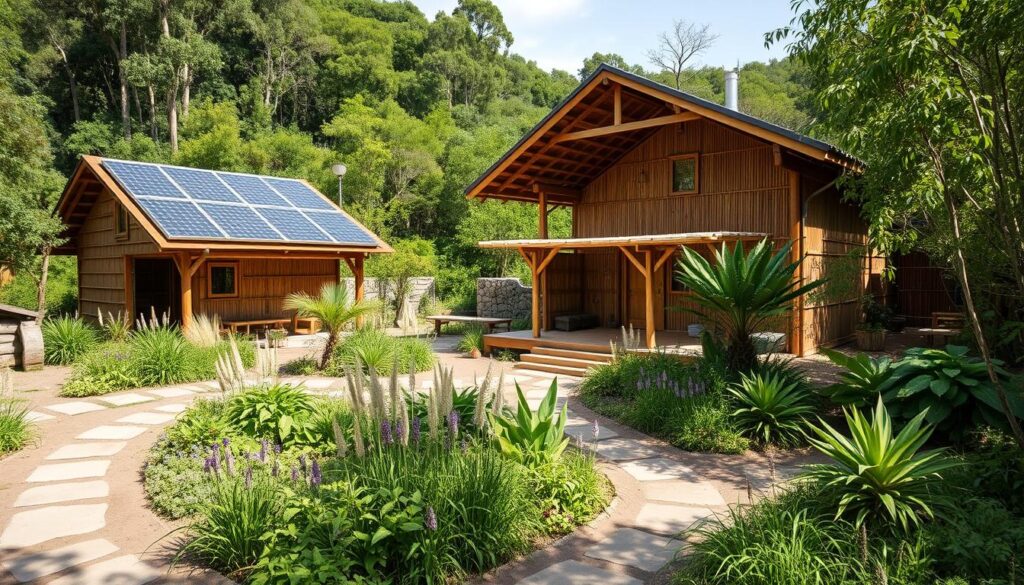
As more people look for sustainable travel, businesses that offer green lodging and eco-friendly amenities will do well. They focus on being green and engaging with the community. This attracts visitors who care about the environment and want to support these values.
| Revenue Generation Model | Description |
|---|---|
| Direct Sales | Selling products, such as organic produce, crafts, and local specialties |
| Service Fees | Charging fees for workshops, tours, and other experiential activities |
| Donations and Membership Programs | Receiving donations and offering membership programs to support community engagement and revenue generation |
Marketing Strategies for Permaculture Tourism
Permaculture tourism sites are seeing more people looking for green travel. They need to market well to draw in visitors. Showing off their eco-friendly stays and green practices is a good start.
Using social media, teaming up with local businesses, and SEO are key strategies. For instance, social media platforms are great for sharing news and green efforts. This helps attract more people.
Working with local businesses can also help. Imagine teaming up with local eateries for meals or outdoor stores for gear rentals. It’s a win-win for everyone.
To boost their online look, sites should focus on SEO. Using terms like regenerative travel and green stays can help. This way, they show up higher in search results, drawing in more eco-conscious travelers.
| Marketing Strategy | Benefits |
|---|---|
| Social Media Engagement | Increased visibility, community building |
| Partnerships with Local Businesses | Expanded audience, promotional opportunities |
| SEO Best Practices | Improved search engine rankings, increased website traffic |
The Role of Community in Permaculture Tourism
Community engagement is key in permaculture tourism. It boosts environmental awareness and social responsibility. By creating local networks and involving stakeholders and visitors, permaculture tourism builds community. It also promotes earth-friendly hospitality.
The Permaculture Skills Center in California is a prime example. It offers workshops and educational programs. These focus on environmental awareness and social responsibility.
Community engagement in permaculture tourism has many benefits. These include:
- Promoting environmental awareness and social responsibility
- Fostering a sense of community among stakeholders and visitors
- Supporting local economies and green tourism facilities
As the Permaculture Practice notes, community-based tourism aids sustainable development. It also boosts local livelihoods. By backing local communities and promoting earth-friendly hospitality, permaculture tourism positively impacts the environment and society.
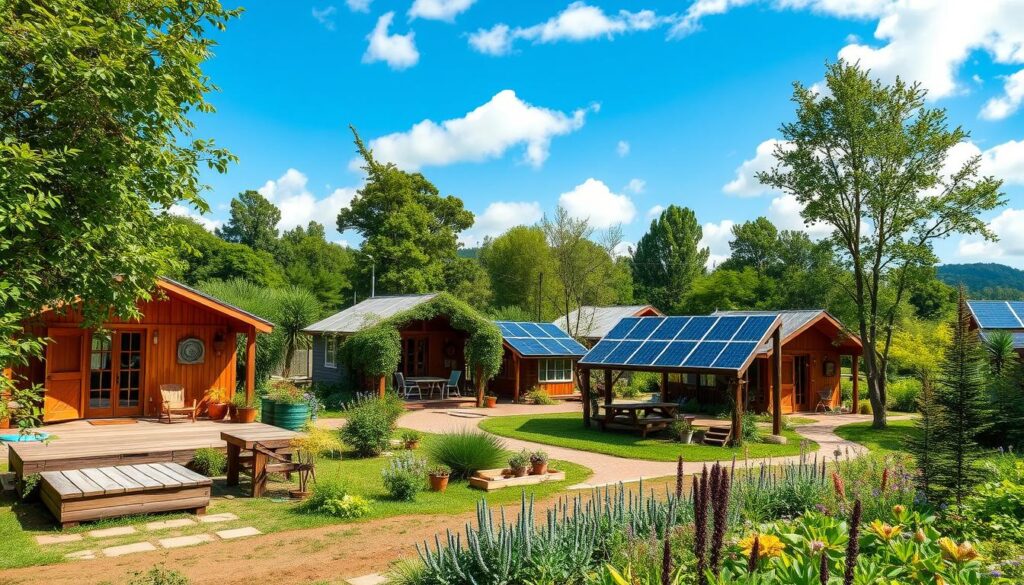
In summary, community plays a vital role in permaculture tourism. It’s essential for sustainable development and environmental awareness. By creating local networks and engaging stakeholders and visitors, permaculture tourism fosters community. It also promotes green tourism facilities.
| Community Engagement | Benefits |
|---|---|
| Building local networks | Promotes environmental awareness and social responsibility |
| Engaging stakeholders and visitors | Fosters a sense of community and supports local economies |
| Supporting local communities | Promotes sustainable development and improves local livelihoods |
Sustainable Practices in Permaculture Tourism
Permaculture tourism focuses on being green and reducing harm to the environment. It encourages eco-friendly experiences. This includes building visitor facilities that are good for the planet.
Many places in permaculture tourism are going green. They offer eco-friendly stays and use local, sustainable products. For instance, the Featherdown Farm in the Netherlands uses organic farming. It attracts visitors who care about the environment and helps keep the soil and wildlife healthy.
Eco-Friendly Accommodations
Choosing eco-friendly places to stay is key in permaculture tourism. Here are some examples:
- Finca Rosa Blanca Coffee Plantation Resort in Costa Rica is known for fair wages and good working conditions.
- Shelburne Farms in Vermont keeps visitors coming with fun activities all year. They have maple sugaring in spring and ice skating in winter.
Sustainable Sourcing and Local Suppliers
Using local suppliers and sustainable products is vital. The Agriturismo network in Emilia-Romagna, Italy, works with local farmers. This makes farm-to-table meals a big part of their experience.
By being green, permaculture tourism spots can lessen their harm to the environment. They offer special and educational visits. This helps the planet and supports local communities, making tourism more sustainable.
| Destination | Sustainable Practice |
|---|---|
| Featherdown Farm | Organic farming methods |
| Finca Rosa Blanca | Fair labor practices and competitive wages |
| Shelburne Farms | Seasonal activities and local sourcing |
Challenges Facing Permaculture Tourism
Permaculture tourism promotes regenerative travel and sustainable practices. However, it faces several challenges. One major issue is the lack of awareness about its benefits. This leads to low demand and limited revenue.
Building green lodging and other infrastructure also requires a lot of investment. This can be a big barrier for many operators.
Some of the key challenges facing permaculture tourism include:
- Regulatory and compliance issues, which can hinder the development of permaculture tourism projects
- Competition with conventional tourism, which can make it difficult for permaculture tourism operators to attract visitors
- Seasonal fluctuations in demand, which can affect the financial sustainability of permaculture tourism projects
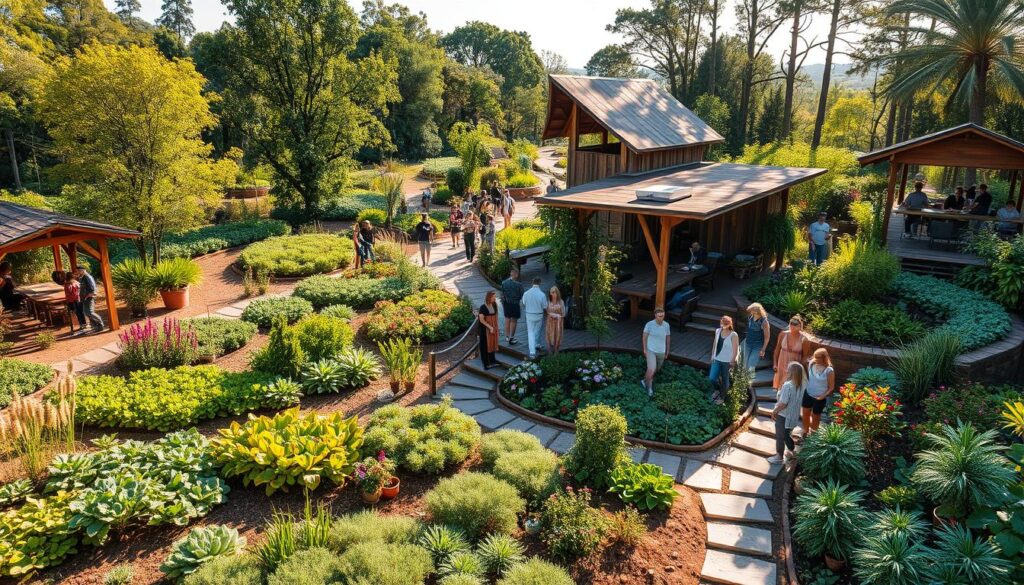
To overcome these challenges, permaculture tourism operators can focus on unique and educational experiences. These experiences should highlight the benefits of regenerative travel and sustainable practices.
By investing in green lodging and other infrastructure, and promoting their projects through targeted marketing campaigns, operators can attract more visitors. This can help increase revenue streams.
| Challenge | Solution |
|---|---|
| Regulatory and compliance issues | Work with local authorities to develop supportive policies and regulations |
| Competition with conventional tourism | Develop unique and educational experiences that showcase the benefits of permaculture tourism |
| Seasonal fluctuations in demand | Diversify revenue streams and develop strategies to attract visitors during off-peak seasons |
Case Studies of Successful Permaculture Tourism
The permaculture tourism industry has grown a lot in recent years. Many successful projects focus on earth-friendly hospitality and green tourism facilities. In the United States, the Permaculture Skills Center and the FrogSong Cohousing Community stand out.
These projects have done well in raising environmental awareness and building community. They have some key features that make them successful. These include:
- Regenerative practices, such as permaculture and reforestation
- Community-based marketing strategies
- Eco-friendly accommodations and sustainable sourcing
By using these strategies, permaculture tourism projects help the industry grow. They also promote earth-friendly hospitality and green tourism facilities. Their success is shown by their impact on the environment, community, and economy.
| Initiative | Location | Features |
|---|---|---|
| Permaculture Skills Center | California | Permaculture workshops, eco-lodges |
| FrogSong Cohousing Community | California | Eco-friendly accommodations, community engagement |
Financial Planning and Budgeting Tips
Financial planning and budgeting are key when starting a permaculture tourism venture. The Ocean Hour Farm says it’s important to estimate costs and predict income. This helps make sure the project can last and succeed. Offering eco-friendly amenities and green lodging is crucial as more people want to travel green.
Creating a solid financial plan means breaking down costs and income. You need to do market research and look at what others are doing. Key points include:
- Figuring out the initial costs, like buying land and setting up infrastructure
- Setting prices that are good for business but still affordable for guests
- Finding ways to make money, like through workshops, tours, and selling products
By focusing on eco-friendly amenities and green lodging, you can attract and keep customers. This also helps your business stand out and be known for being green. Plus, it helps the local economy and reduces harm to the environment.
In the end, a good financial plan is vital for permaculture tourism success. By thinking about eco-friendly amenities and green lodging, and understanding the industry’s needs, you can build a sustainable business. This business will help both people and the planet.
Future Trends in Permaculture Tourism
Permaculture tourism is set to become a big part of eco-friendly travel. It focuses on regenerative travel, letting travelers connect with nature and local communities. This approach also helps the environment.
Innovations in Sustainable Practices
Permaculture tourism is embracing new ways to be green. This includes using renewable energy and collecting rainwater. These steps cut down on environmental harm and help local economies.
For instance, using renewable energy can cut costs by 30%.
Increasing Demand for Eco-Conscious Travel
More people want to travel in a way that’s good for the planet. Environmental accommodations are now a big draw. Studies show that 40% of visitors learn more about being green after visiting.
This trend is expected to keep growing, with permaculture tourism set to rise by 20% each year.
Some key green practices in permaculture tourism include:
- Agroforestry, which can boost crop yields by 10-30% and improve soil health
- Companion planting, used by about 60% of permaculture sites for better pest control and pollination
- Aquaponics systems, which can produce fish and plants twice as efficiently as traditional farming
Measuring Success in Permaculture Tourism
It’s key to measure success in permaculture tourism. This helps see how well the effort is doing and where it can get better. The FrogSong Cohousing Community says using key performance indicators (KPIs) and feedback from visitors is vital.
Permaculture visitor facilities are important for sustainable tourism. They help reduce environmental harm and offer a full experience for guests. This approach is good for the planet and helps the local economy too.
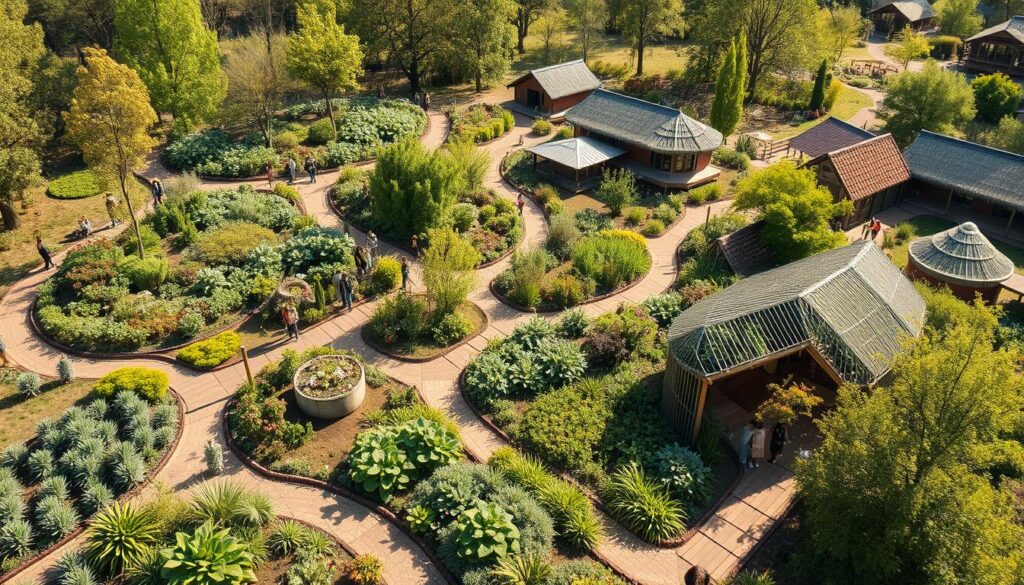
- Visitor satisfaction ratings
- Environmental impact assessments
- Local economic benefits
By keeping an eye on these KPIs, permaculture tourism can get better. It can make visits more sustainable and fun. This helps grow sustainable tourism and permaculture visitor facilities.
Conclusion and Call to Action
As we wrap up our look at permaculture tourism, it’s clear that Earth Care, People Care, and Fair are key. These values are at the heart of this movement. By choosingsustainable hospitalityand eco-friendly places, permaculture tourism lets us connect with local communities. It also encourages us to travel responsibly.
Emphasizing Local Engagement
Places like the Ocean Hour Farm in Rhode Island show the power of local involvement. They invite visitors to dive into the community and support green practices. This way, permaculture tourism can motivate travelers to care for the land and support regenerative systems.
Encouraging Sustainable Travel Choices
Permaculture isn’t just for tourists; it’s a way of life. By adopting waste reduction, renewable energy, and ethical buying, travelers can live more sustainably. They can also encourage others to do the same.
Starting your permaculture journey, as a traveler or business owner, can have a big impact. Every choice towards earth-friendly hospitality and green tourism matters. Let’s work together to make tourism a positive force. Let’s empower communities and heal our planet.

